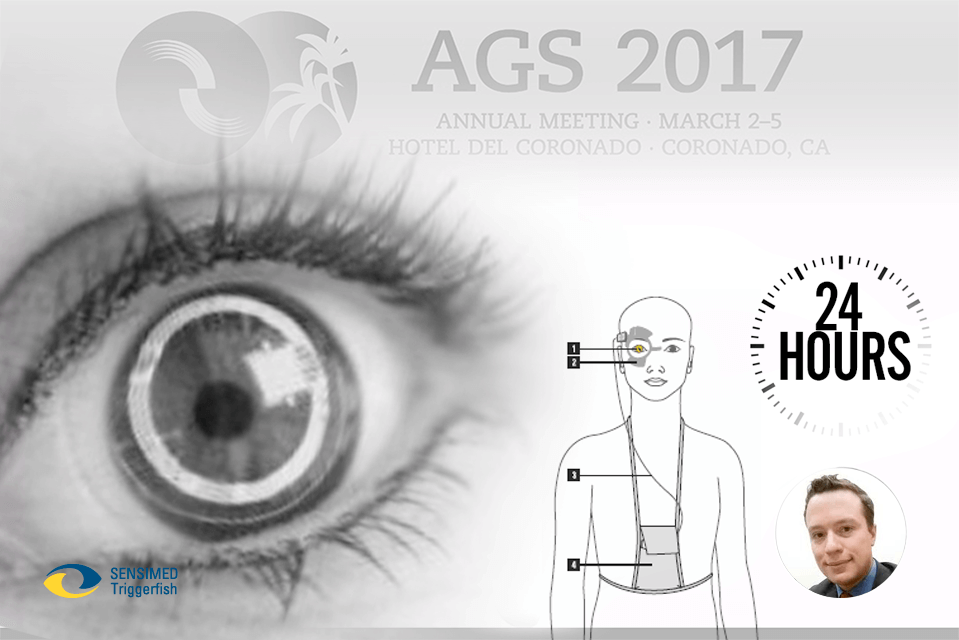
Photo Sources: www.sensimed.ch and www.columbiaeye.org
SENSIMED Triggerfish® Could Predict the Risk of Worsening Visual Field Loss
It’s pretty well accepted among both patients with glaucoma as well as their doctors that measuring intraocular pressure (IOP) once every few months is far from ideal. The eye pressure is known to fluctuate throughout the day, glaucoma medications have both “peak” and “trough” effects, and the device and person measuring the IOP can impact the measurement.
For the above reasons, the desire to continuously measure IOP has been strong. The FDA approved SENSIMED Triggerfish® contact lens contains a strain gauge which measures changes in the surface of the eye that correlate with IOP. Though not actually a measurement of IOP, it does provide a large amount of data over a 24 hour period. The question remains, however, “What does one do with this data?”
Dr. Gustavo De Moraes addressed the question at the American Glaucoma Society (AGS) 2017 Annual Meeting in San Diego, California during the presentation of his paper, “24-Hour IOP-Related Profile with a Contact Lens Sensor Is Associated with Visual Field Progression in Treated Glaucoma Patients: A Multicenter Study”1.
His team of researchers showed that a number of data parameters obtained from wearing the SENSIMED Triggerfish® contact lens for 24 hours were associated with worsening visual fields. This finding is so incredible and unintuitive that it deserves rephrasing:
A single 24 hour measurement with the SENSIMED Triggerfish® contact lens could predict the risk of worsening visual field loss over the next 5 years!
How could this data be used? For one, those who fell into the “low risk” group (based on 24 hour contact lens monitoring) might be able to avoid or delay additional medications or even the risk of surgery given the expectation that they would be less likely to lose vision over time.
Even more critical, those who fall into the “high risk of progression” group could be treated more aggressively in order to prevent loss of vision. The decision to accept the risk of surgery in order to prevent vision loss is fraught with uncertainty. “Am I making the right decision to proceed with glaucoma surgery?” is a common question and one that leads to significant patient and surgeon stress. It appears that one 24 hour measurement with the SENSIMED Triggerfish® contact lens could provide some much-needed peace of mind.
Dr. Moraes and his team have provided us with some very exciting data that could be used to address not only the treatment of glaucoma, but also the uncertainty felt by both patient and doctor with each treatment decision. Now for the real challenge: getting insurance companies to realize the value in this method of glaucoma monitoring.
Reference:
- De Moraes CG, Jasien JV, Simon-Zoula S, Liebmann JM, Ritch R. Visual Field Change and 24-Hour IOP-Related Profile with a Contact Lens Sensor in Treated Glaucoma Patients. Ophthalmology 2016;123(4):744-53.

David Richardson, MD
Medical Director, San Marino Eye
David Richardson, M.D. is recognized as one of the top cataract and glaucoma surgeons in the US and is among an elite group of glaucoma surgeons in the country performing the highly specialized canaloplasty procedure. Morever, Dr. Richardson is one of only a few surgeons in the greater Los Angeles area that performs MicroPulse P3™ "Cyclophotocoagulation" (MP3) glaucoma laser surgery. Dr. Richardson graduated Magna Cum Laude from the University of Southern California and earned his Medical Degree from Harvard Medical School. He completed his ophthalmology residency at the LAC+USC Medical Center/ Doheny Eye Institute. Dr. Richardson is also an Ambassador of Glaucoma Research Foundation.


